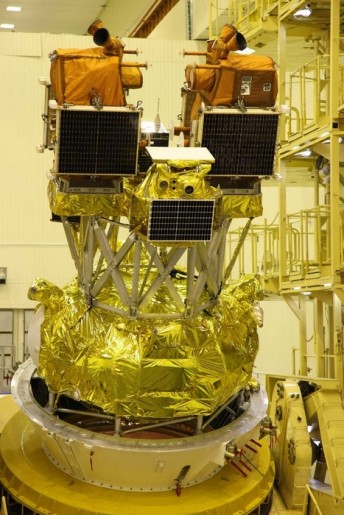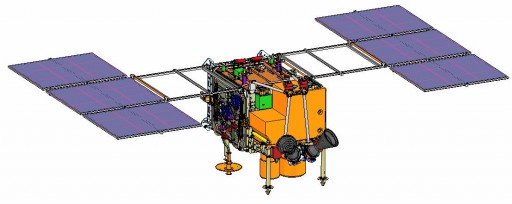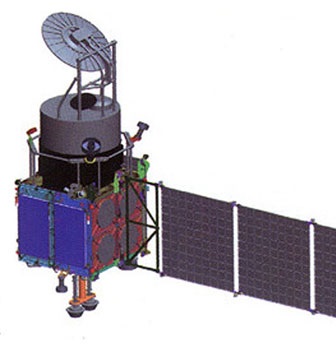Kanopus ST Satellite Overview

Kanopus-ST is a Russian remote sensing satellite dedicated to ocean and weather research as part of the Kanopus satellite program that serves a dual role under military and civilian operation with a possible application of detecting submarines roaming the world’s oceans.
The first Kanopus satellite was launched in July 2012. Designated Kanopus V-1, the satellite had a launch mass of 475 Kilograms and was based on the Kanopus satellite platform, designed specifically for the program. The satellite hosts a panchromatic imaging system that can deliver imagery at a 2.5-meter ground resolution across a 20-Kilometer swath. A Multispectral Imaging System delivers full-color and near-infrared imagery, achieving a ground resolution of 12 meters. A third instrument, a Multispectral Scanner Unit delivers data for an assessment of land and sea ice cover at a resolution of 25 meters. The BKA satellite launched for Belarus was an almost exact copy of Kanopus V-1.
The second Kanopus V satellite has been modified with an added infrared imaging payload and is expected to launch in 2016 as Kanopus V-IK 1. The Kanopus V satellites are being used for mapping, disaster monitoring, detection of forest fires, studying space-based methods for earthquake prediction, land resources monitoring and operational applications. A total of six Kanopus satellites are expected to be launched until 2020.
Contracted for the development of the Kanopus satellites, NPP VNIIEM elected to work with Surrey Satellite Technology Ltd. based in the United Kingdom given their experience with small satellites. Under the contract signed in 2007, SSTL is delivering three suites of satellite avionics and software plus technical support, electrical power management and batteries, onboard computers and data handling systems. The company will also provide spacecraft assembly and integration support.

The Kanopus satellite bus hosts a deployable solar array with an average power supply of 300 Watts. The spacecraft host precise attitude determination and control systems featuring star trackers, sun sensors, and inertial measurement systems for attitude determination and reaction wheels as primary attitude actuators. The satellite platform supports precise pointing with an attitude stability of 0.001 degrees per second. Imaging at off-nadir angles up to +/-40 degrees can be supported, requiring 2 minutes for a slew from –40° to +40° off-nadir, allowing the satellite to conduct agile imaging operations with quick re-targeting.
The Kanopus satellites have an onboard memory of 24 gigabytes. Data downlink is accomplished using an X-Band communications system operating between 8.048 and 8.382 GHz and achieving data rates up to 122.8 Megabits per second.
Kanopus ST is not built by VNIIEM. Its contract was awarded to PO Polyot in 2008 with funding coming from the Russian Ministry of Defence.

According to official documentation, the Kanopus ST satellite weighs 350 Kilograms and stands about 2.6 meters tall. A single solar array, 4.4 meters in length delivers power to the satellite systems. The satellite’s attitude control system achieves a pointing accuracy on the order of 30 angular minutes with excellent pointing stability for imaging.
A Microwave radiometer with a conical scanning geometry achieves a swath width of 2,200 Kilometers and a resolution of 12 to 160 Kilometers. The second payload is a multi-spectral imaging system covering the visible wavelengths across a 1,000-Kilometer swath, reaching a spatial resolution of 30 to 50 meters.
Kanopus ST is dedicated to remote sensing across the global oceans and land for weather research and operational hydrometeorological applications. Comments made by Russian Military Officials in 2010 indicated that the Kanopus ST satellite would be capable of scanning the underwater areas for submarines, however, the published specifications would not permit such a detection. Nevertheless, after these comments were made, all information on the Kanopus ST satellite and its preparation for launch was restricted, indicating a military-directed mission.
Information published in the years leading up to the launch shows the satellite targeting an operational Sun Synchronous Orbit of 702 Kilometers at an inclination of 98.7 degrees.
Launching as a secondary payload atop the Soyuz 2-1v rocket will be the КЮА 1 calibration sphere that is similar to the SKRL-756 radar calibration spheres that went up on the maiden launch of the Soyuz 2-1v in late 2013. The polished sphere has a mass of 15.8 Kilograms and is affixed to the side of the cylindrical payload adapter sitting atop the Volga Upper Stage for release after the completion of the primary mission. The passive sphere will serve as target for ground-based radars as part of calibrations and orbit determination operations.
